Which Animal Has The Highest Population In Antartica
Sub-nada temperatures, months of darkness and some of the strongest winds on Earth. How does life survive in this vast polar desert?
Despite the many challenges, Antarctica is teeming with life. Information technology is dwelling to billions of krill, millions of seals and more penguins than anywhere else on the planet.
Read on to learn most some of this wonderful wildlife, and their remarkable adaptations to a continent that is so common cold and dry, some scientists compare it to the Moon.
Penguins
When it comes to Antarctic wild animals, penguins often steal the show. Eight of the world's eighteen penguin species alive in Antarctica and on subantarctic islands.
While these flightless seabirds tin be a piffling ungainly on land, they are boggling swimmers. With streamlined bodies similar torpedoes, they employ their flippers like wings for propulsion in the water, and their anxiety (and sometimes tail) to steer their course.
Penguins feed at sea, coming ashore to brood, rest and supercede all their feathers at in one case in an annual catastrophic moult. With their mathematically precise huddles and pebble-stealing antics, they take adult some truly remarkable ways of thriving in this harsh environment.
Allow's larn a flake about some of the different species we find in Antarctica.
Emperor penguins
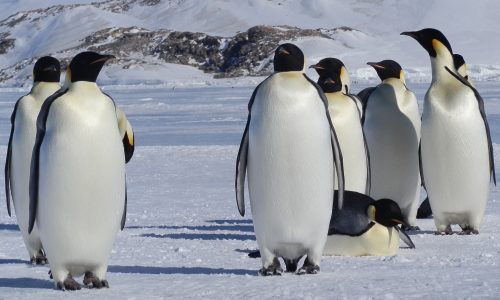
Fast facts
Scientific proper noun: Aptenodytes forsteri
Height: avg 1.1 – 1.3m (43-51in)
Weight: 22 to 45 kg (49 to 99 lb)
Boilerplate lifespan in the wild: 15-xx years
IUCN Reddish List status: Near threatened
The largest penguin species on the planet, emperor penguins live further south than any other penguin.
While most penguins drift north for the wintertime, emperors head s to breed in colonies up to 200km (125 miles) from the coast. In these icy colonies, emperor penguins can withstand temperatures as low as – l°C (- 58°F) with winds gusting up to 200km per hour (124mph).
They form dense huddles, which are so constructive at creating warmth that penguins in the centre of these cosy formations can enjoy temperatures of up to 37C (100F), even in air temperatures that are well below freezing!
Emperor penguins feed mainly on fish, krill and squid, and their remarkable diving skills give them admission to some of the coldest, richest waters on Earth. The deepest recorded dive by an emperor penguin was up to 565m (1850 ft) deep: deeper than any other bird. They can stay underwater for 20 minutes, but the average dive is closer to 5 minutes and around 100 to 200 metres (328 ft to 656 ft).
Although emperor penguins tin't fly, they can leap up to three metres. They exercise this by diving deep and filling their feathers with a cloak of bubbles, which helps them launch into the air and leap onto the ice!
Adélie penguins
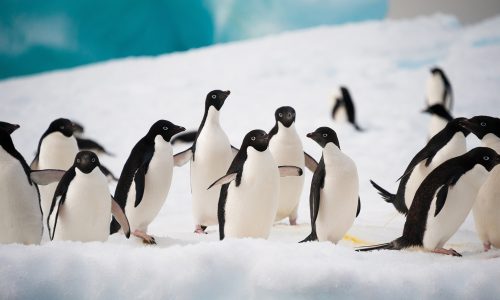
Fast facts
Scientific name: Pygoscelis adeliae
Tiptop: avg 46 to 71 cm (eighteen to 28 in)
Weight: 3.6 to six.0 kg (7.ix to 13.2 lb)
Boilerplate lifespan in the wild: x–20 years
IUCN Red Listing status: Near threatened
These delightful birds are the smallest penguin species in Antarctica. Known for their sleek blackness and white colouring that resembles a tuxedo, the distinctive white ring effectually their eyes is an important identifying feature.
Similar emperor penguins, Adélies alive and breed exclusively in the polar regions. In fact, they are the only ii penguin species that alive permanently in Antarctica! All the same Adélie penguins have more in mutual with gentoo and chinstrap penguins, both of which aremembers of the brush-tailed penguin family .
Adélie penguin colonies tin can be institute on rocky outcrops across the Antarctic coastline, where they build nests from small stones. In addition to providing shelter for incubating eggs and young chicks, the pebbles can be offered up to an object of amore as part of a courting ritual, and Adélie males are well-known for their cheeky pebble-stealing antics.
Adélie penguins lay two eggs annually, which hatch in early summer (usually December/January). Afterwards near a month, Adélie chicks are set up to leave the security of their parents' nest and strike out with other penguin chicks in rowdy groups called creches. After ii-three months their downy plume is replaced past adult feathers and they are ready for life at sea.
Adélie penguins eat some fish and squid, but they rely on krill for most of their diet. This dependence on krill makes them vulnerable to changes in body of water conditions. Beyond the rapidly warming Antarctic Peninsula, their numbers have dropped by 70-90% since 1982. Despite this, their numbers are increasing across Antarctica.
Gentoo penguins

Fast facts
Scientific proper noun: Pygoscelis papua
Height: avg 51 to 90 cm (20 to 35 in)
Weight: 4.5 kg – 8.five kg (9.9 lb – xix lb)
Average lifespan in the wild: xv–20 years
IUCN Red List status: To the lowest degree concern
Gentoo penguins are the third-largest member of the penguin family, plant across the Antarctic Peninsula and several subantarctic islands. Their distinctive orange beaks and peach-coloured feet provide a flash of color against an otherwise stark landscape.
Like their brush-tailed cousins, the Adélies and chinstraps, they seek out ice-free patches for their colonies, building nests out of stones. They are often found congregating on low-lying, rocky beaches in groups of a few to a few thousand. They by and large lay 2 eggs, sometimes three. Chicks are born in early summertime (December/January), and inside a month they congregate in creches with other chicks. In March, they begin testing the waters every bit they fledge and start foraging for their own food.
Gentoo penguins accept a diverse diet of fish, squid and krill. This flexibility has made them resilient to changes in sea temperatures and reduced bounding main ice comprehend. Although the population of Adélie penguins appears to be decreasing across the Antarctic Peninsula, gentoo penguins are expanding.
They can swoop upwardly to 200m (655 ft) and stay underwater for up to 7 minutes, but their great strength is their speed. They are the fastest penguin on Earth, capable of swimming up to 36km/h (22 mph).
Chinstrap penguins
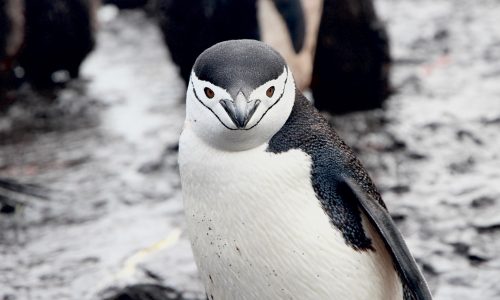
Fast facts
Scientific proper noun: Pygoscelis Antarcticus
Superlative: avg 68–76 cm (27–thirty in)
Weight: 3.ii–5.3 kg (vii.one–eleven.7 lb)
Average lifespan in the wild: 15–20 years
IUCN Ruby-red List status: Least concern
Found beyond the Antarctic Peninsula and several Antarctic and subantarctic islands, the plucky chinstraps are the most numerous penguins in Antarctica. In the remote S Sandwich Islands archipelago, there are enormous colonies of around 1.2 million breeding pairs, like the ane featured in BBC's Planet Earth II.
Their name is derived from the blackness line under their chin which, combined with their black cap-like head colouring, makes them look like they're wearing a little helmet.
Chinstraps are among the more gymnastic of the brush-tailed penguins, often building their nests on exposed rocky bluffs with hazardous access routes! Like Adélie and gentoo penguins, they generally lay two eggs. Chicks are built-in in early summertime (Dec/January), and join creches with other chicks within near a month. Past March, they are ready to fledge and begin their life every bit an adult.
Globe travellers, chinstrap penguins are mutual from the Antarctic Peninsula to islands across the subantarctic, but have been spotted as far north equally New Zealand!
Like all penguins, their main predators at sea are leopard seals. On land, predatory seabirds such as skuas, southern giant petrels and snowy sheathbills pose a threat, particularly to fluffy chicks.
King penguins
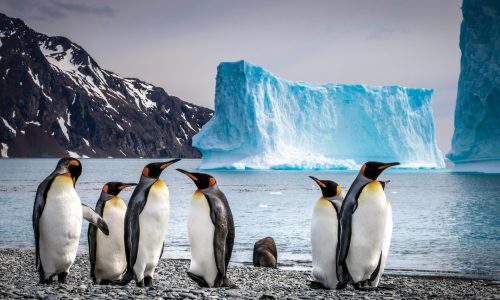
Fast facts
Scientific proper noun: Aptenodytes patagonicus
Height: avg seventy to 100 cm (28 to 39 in)
Weight: ix.3 to 18 kg (21 to twoscore lb)
Average lifespan in the wild: ~26 years
IUCN Ruby List status: Least concern
Second in size only to the emperor, these stately birds alive in bustling colonies on subantarctic islands north of Antarctica. Sometimes confused with emperor penguins due to their colourful plumage and orange cheeks, king penguins practice not visit Antarctica, preferring the relatively temperate atmospheric condition a piffling farther north, betwixt 45° and 55°S.
Male monarch penguins are graceful swimmers, and can ofttimes be spotted from the send porpoising (leaping) out of the water to breathe, pick upwardly speed and evade predators. They feed primarily on fish and squid, and return to shore to breed in enormous colonies.
Some colonies in South Georgia are domicile to upwards to 150,000 breeding pairs. That's over 300,000 boisterous, wing-flapping birds! Serially monogamous, king penguins observe their partner in the crowd past listening out for their unique call amid the cacophony of thousands of trumpeting penguins.
King penguins have a unique 13-xvi month breeding bicycle, which means that they can take a maximum of one chick every 2 years, or two chicks every three years. They incubate their eggs on their feet, like emperor penguins.
Seals
From the crabeater seal that doesn't eat crabs, to the Weddell seal that sings like a infinite invader, Antarctic seals are fascinating – and sometimes a petty furry.
Protected nether the Antarctic Treaty'southward Convention for the Conservation of Antarctic Seals, these marine mammals are flourishing in the cool haven of the Southern ocean. Permit'due south take a closer look at some of the most common seals in Antarctica.
Weddell seals
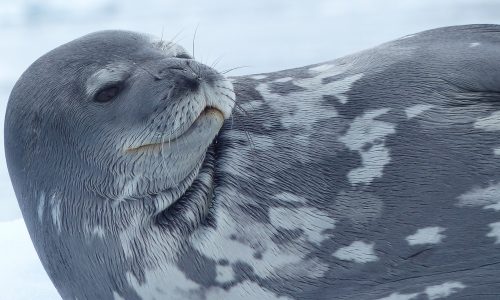
Fast facts
Scientific name: Leptonychotes weddellii
Length: avg 2.5–three.5 1000 (8 ft two in–xi ft 6 in)
Weight: 400–600 kg (880–1,320 lb)
Boilerplate lifespan in the wild: 30 years
IUCN Blood-red Listing status: Least concern
Weddell seals are the almost southerly breeding mammal on Earth. They never venture also far from home, preferring to range within l-100km (31mph – 62mph) of their booty-outs on the fast-ice surrounding Antarctica.
During the summer, Weddell seals roam effectually the bounding main ice to feed on small-scale fish, crustaceans and other modest marine life – sometimes even penguins! They haul out onto the ice to balance, moult and pup.
When the ocean congeals into sea ice, they cleave holes in the surface using their abrupt canines and incisors. They apply these holes, often called breathing holes, to admission the bountiful waters below.
Weddell seals are prodigious divers and navigators, diving up to 700m deep and staying underwater for up to eighty minutes, before finding their way back to their small breathing holes, fifty-fifty in the 24-hour darkness in the depth of wintertime.
This is a remarkable, only perilous system. It takes consistent maintenance to prevent these animate holes from freezing over. Over time their teeth wear downwardly, and they become unable to maintain their own animate holes. This is thought to exist a common cause of Weddell seal mortality.
Known for their remarkable call, the Weddell seal'due south circuitous symphony of otherworldly chirps and chimes has been described by some every bit similar a 'sci-fi spaceship' or the telephone call of a distant alien civilisation!
Crabeater seals
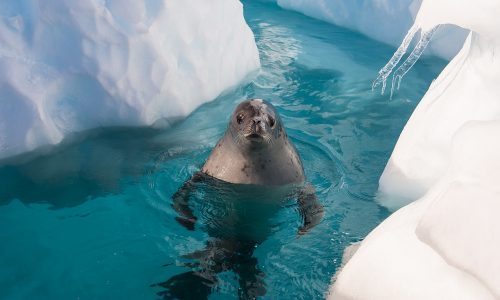
Fast facts
Scientific proper noun: Lobodon carcinophaga
Length: avg 2.iii m (vii.5 ft)
Weight: 200 kg (440 lb)
Average lifespan in the wild: 20-40 years
IUCN Carmine List condition: Least concern
With a circumpolar distribution and an estimated population equally high as 15 million, crabeater seals are the nigh abundant seal species in the world.
They spend the majority of their lives around the pack-water ice surrounding Antarctica, although vagrants have been spotted as far n equally Commonwealth of australia. In 2016, a lonely crabeater seal was spotted on Anglesea beach in Victoria!
Oddly plenty, crabeater seals don't eat venereal. Their name, which has confused many travellers, comes from the German give-and-take 'krebs', which ways crabs, crayfish and crustaceans in general.
Crabeater seals eat more krill (Euphasia superba) than any other seal species on World. Afterwards taking in a mouthful of krill and seawater they employ their specialised, lobed (lobodontine) teeth to strain out the water.
It's always a delight to spot these sociable seals congregating in pocket-sized groups on ice floes around the Antarctic Peninsula. They are most commonly spotted in groups of less than ten, but there take been reports of enormous groups of upwardly to k crabeaters hauling out on the ice to rest, moult and breed.
Leopard seals

Fast facts
Scientific name: Hydrurga leptonyx
Length: avg 2.four–iii.5 one thousand (seven.9–11.5 ft)
Weight: 200 – 600kg (440 – 1,320lb)
Boilerplate lifespan in the wild: 12-26 years
IUCN Blood-red List status: Least concern
The 2nd-largest of the Antarctic seals, leopard seals are solitary animals and formidable hunters. They accept a broad diet which, dissimilar other Antarctic seals, includes other marine mammals.
Leopard seals are not picky eaters, and will happily dine on a variety of fish, squid, small crustaceans, penguins and fifty-fifty pocket-sized seals. Highly effective predators, their sleek, ophidian-like trunk moves stealthily through the water at speeds of up to 40km/h (25mph), and their powerful jaws clamp down firmly on their casualty.
Despite their grisly reputation and penchant for feathered and furry prey, almost half of a leopard seals' nutrition is made up of krill and small crustaceans. They consume these past filter-feeding through peculiarly grooved teeth, much like the crabeater seal.
Female leopard seals are larger than their male counterparts, growing up to 3 metres (10 feet) and reaching weights of 590kg (1300lb).
Found along the coasts of Antarctica and subantarctic islands, in 2017 they were spotted on beaches effectually Tasmania.
Southern elephant seals
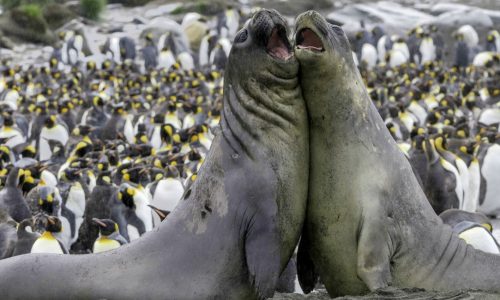
Fast facts
Scientific proper name: Mirounga leonina
Length:
Female 2.6 to 3 m (8.5 to 9.8 ft)
Male 4.2 to 5.8 m (fourteen to xix ft)
Weight:
Female 400 to 900 kg (880 to 1,980 lb)
Male 2,200 to iv,000 kg (4,900 to viii,800 lb)
Boilerplate lifespan in the wild: 21 years
IUCN Reddish Listing status: To the lowest degree concern
The giants of the Antarctic seals, southern elephant seals are the largest seals on the planet, and the largest mammals on Earth, apart from whales. Yet, they earn their name not from their size but from the long, body-like snouts sported by adult males.
Foraging widely across the Southern ocean, southern elephant seals breed in densely packed colonies on subantarctic islands.
Dominant males surround themselves with a harem of 40 to 50 females, which they fiercely defend against hopeful interlopers. Tearing clashes are a common sight on South Georgia's beaches during mating season, with males battling for supremacy in ambitious, sometimes grisly matches.
Elephant seals often bunch together in muddied pits called wallows, using their small-scale flippers to cover themselves with cool, wet sand.
Once hunted to nearly-extinction for the rich oil rendered from their blubber, elephant seal populations have rebounded well nether strong protections in recent decades.
Whales
During the Antarctic summer, these leviathans of the deep flock to Antarctic waters in astonishing numbers to feast on the veritable bounty of Antarctic krill (Euphasia superba) that flourishes amidst the sea water ice.
They generally begin to get in in Antarctica in November, reaching peak numbers in Feb and March. Allow's take a expect at some of the whales nosotros come across in Antarctica.
Humpback whales
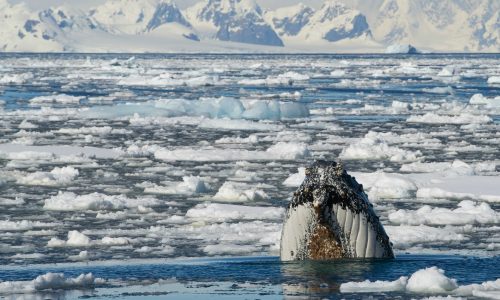
Fast facts
Scientific name: Megaptera novaeangliae
Length:
Female avg 15–sixteen yard (49–52 ft)
Male avg 13–xiv g (43–46 ft)
Weight: avg 25–xxx metric tons (28–33 short tons)
Average lifespan in the wild: 45-50 years
IUCN Cherry-red List condition: Least business organisation
These majestic giants are among the bully wanderers of the bounding main, travelling upwards to 10,000km (6,200 miles) on their annual migration from their breeding grounds in the north to their feeding grounds in the due south. This is the longest known almanac migration of any mammal (although some say the grey whale migration may exist further).
Humpback whales travel in pods, feeding on minor fish, crustaceans and the abundant krill found in the nutrient-rich waters of the Southern ocean. They use co-operative hunting techniques such as bubble-net feeding to corral huge swarms of Antarctic krill into a small surface area, before sweeping the thick soup of krill and water into their enormous, pleated gullet. They filter the water out using their huge baleen plates, made of a gristly cloth a bit like our fingernails. Then they swallow a hearty mouthful of krill.
They are somewhat stout and stocky compared to other baleen whales, and travel comparatively slower. Females generally abound larger than males, as with all baleen whale species.
Humpback whales are quite curious, and expeditioners to Antarctica may exist treated to wonderful displays of tail-slapping, pectoral fin-waving, breaching (leaping out of the water) or even humpback whales swimming towards the send for a closer look.
Antarctic / Southern Minke whale
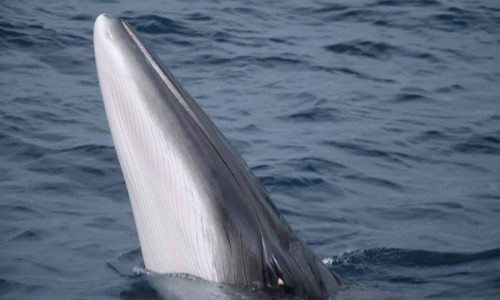
Fast facts
Scientific name: Balaenoptera bonaerensis
Length:
Female avg 8 m (26 ft)
Male avg six.9 m (23 ft)
Weight: avg 4–5 t (3.9–4.9 long tons; iv.4–5.five brusk tons)
Boilerplate lifespan in the wild: 30-50 years
IUCN Red List condition: Near threatened
The minke whale is one of the smallest baleen whales. Instead of teeth, baleen whales have curtains of flexible plates in their mouths, called baleen. Baleen plates are fabricated of a material similar to the keratin in our hair and fingernails, and whales can have hundreds of them hanging from their upper jaw. Baleen is similar a colander, allowing whales to filter-feed vast quantities of krill and minor fish.
Inquisitive but shy, minke whales can be spotted by watchful travellers as they charily arroyo vessels, earlier darting abroad or diving speedily, not to resurface for several minutes.
Hunted by Japanese whaling ships until 2019, the minke whale population is currently classified equally well-nigh threatened.
Killer whales / orcas
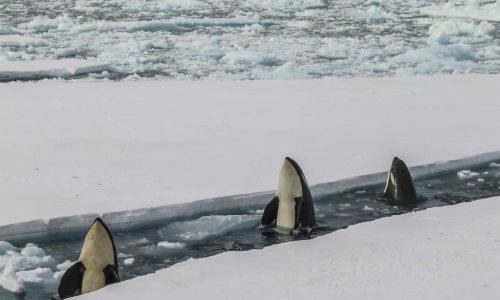
Fast facts
Scientific proper name: Orcinus orca
Length: avg 23 to 32 feet
Weight: Upwards to 6 tons
Boilerplate lifespan in the wild: 50 to 80 years
IUCN Blood-red List status: Unknown (Information Scarce)
Although they are classed as toothed whales, killer whales are technically office of the dolphin family unit. They are the largest of the dolphins, and one of the world'due south well-nigh formidable apex predators. They feed on fish, seals and even other whales.
Known for their extraordinary intelligence, killer whales chase in pods of upwardly to 40 individuals. They use echo-location to communicate, and use cooperative hunting techniques, which some scientists compare to wolves. Watchful visitors to Antarctic waters may encounter them surfacing in the gaps amongst the sea ice, or circumvoluted around icebergs strategising a seal capture.
There are three types of killer whales in Antarctica:
Type A: the largest of the Antarctic killer whales, they prefer open water and feed mainly on minke whales.
Type B: these adopt the pack ice, feeding predominantly on Weddell seals, and likewise possibly penguins. They have a distinctive yellowish colouring on their white patches due to staining from diatoms in the water.
Type C: the smallest Antarctic killer whale, they are typically spotted amongst the pack ice in East Antarctica and are thought to consume mainly fish. Like Blazon B'southward, they have a distinctive xanthous colouring.
Antarctic blue whale

Fast facts
Scientific proper name: Balaenoptera muscle
Length:
Female person: avg 27m (88 ft)
Male: avg 25m (82 ft)
Longest blueish whale ever: 33.58m (110ft 17in) measured at a South Georgia whaling station in the South Atlantic (1909) (Source)
Weight:
Female: 130 tons (260,000 lb)
Male person: 112 tons (224,000 lb)
Average lifespan in the wild: 80-90 years
IUCN Red List condition: Endangered
The blue whale is the largest mammal ever known to accept lived on Earth. A quick online search will reveal the extraordinary scale of these colossal majesties of the deep.
A blueish whale'due south tongue can weigh as much as an elephant. Its heart isthe size of a golf buggy, as heavy as a small motorcar, and yous can hear it beat from 5km (two mi) away. Their call is among the loudest on Globe, with scientists estimating other whales tin can hear their calls 1,600km (1,000mi) abroad.
This extraordinary animal feeds exclusively on krill, consuming up to 4 tons of these tiny crustaceans each day. Usually travelling alone or in pairs, they are mostly solitary animals.
Since being hunted to near extinction in the 18th and 19th centuries, blue whale populations appear to be rebounding. In Feb 2020, a grouping of scientists reported 'astonishing' numbers of blue whales off the coast of South Georgia, where they were once arable and hunted in large numbers. In 23 days their survey counted an boggling 55 blue whales.While blueish whales are still classified every bit endangered , scientists consider this render to their pre-whaling feeding grounds a very expert sign.
In August 2020, a blue whale was seen off the coast of Sydney, Commonwealth of australia, in what is thought to be only the third local sighting in 100 years.
Krill
Fast facts
Length: avg 6cm (two.5 in)
Weight: 2g (0.7 oz)
Scientific name: Euphasia superba
Boilerplate lifespan in the wild: 10 years
Antarctic krill (Euphasia superba) are pocket-sized crustaceans with big, black optics and many small legs called thoracopods. They feed primarily on phytoplankton, and are plant in large numbers across the Southern Body of water.
Krill tend to migrate vertically in the h2o column, rising to the surface and providing food for predators at night, and sinking into the depths during the 24-hour interval.
There are an estimated 500 trillion Antarctic krill in the Southern Ocean, weighing 379 million tons. Scientists gauge that approximately one-half of this is taken up by the seals, penguins and whales that rely on krill every bit their principal source of nutrient.
Antarctic krill is also commercially harvested by humans, mostly in the Scotia Bounding main, to the north of the Antarctic Peninsula. The main uses of harvested krill are aquaculture and aquarium feed, human dietary supplements and bait in sport fishing. Antarctic krill fisheries are regulated and monitored by the Commission for the Conservation of Antarctic Marine Living Resource (CCAMLR).
What animals are endangered in Antarctica?
The most endangered animals in Antarctica are albatrosses. Equally these imperial seabirds soar across the globe they fall prey to oil spills and entanglement in plastic or netting. They are also affected by changes in nutrient concentration, loss of habitat and climate change.
Albatrosses
The wandering and southern regal are the largest albatrosses, and 2 of the about common ones we see on our voyages. They are both classified by the IUCN Red List equally vulnerable to becoming endangered, and wandering albatross numbers are listed every bit decreasing.
Penguins
Of the viii penguin species found in Antarctica, two are vulnerable, two are nigh-threatened and the others have good for you populations.
You tin read more than about Antarctic penguin populations here.
Whales and seals
Antarctic seals and whales were hunted to near-extinction in the 18th and 19th centuries. While commercial sealing officially concluded in 1972, commercial whaling continued in some form until 2019.
Today, humpback whales are thriving and they are listed every bit least concern. However many of the other large baleen whales, including the blue, fin and sei whales, accept been slower to recover.
Blueish and sei whales are both endangered, although their populations are increasing. There is good news for fin whales, which have been downgraded from endangered to vulnerable since 1999, and are increasing.
Despite having been hunted to within an inch of extinction, both fur seals and elephant seals accept strong populations, crowding subantarctic beaches during breeding season and filling the air with their belches and battle cries. In fact, all Antarctic seals are faring well, classified every bit least business.
You can read more about seal populations here.
Due to Antarctica's inaccessibility and challenging inquiry conditions, there are many species scientists still know very little about. There may exist others we accept yet to discover. Equally the ocean warms and the air temperature increases, the race is on to gather as much baseline data about Antarctic wildlife every bit possible.
How accept animals adjusted to Antarctica?
Winter in Antarctica means six months of darkness and temperatures plummeting below -threescore°C (-76°F). While humans might put on a warm downwardly jacket and a head-torch to survive, Antarctic animals take a different approach. They have developed all kinds of handy adaptations to help them thrive in a climate that tin can seem impossibly harsh.
At home at sea
The Antarctic continent itself is barren, windswept and covered in ice. By contrast, the sea surrounding it is teeming with life.
All Antarctic animals (with the exception of tiny invertebrates and 1 scavenging bird, the snowy sheathbill) spend most of their lives feeding in the nutrient-rich waters surrounding the continent. Underwater, they are protected from the extremes of the Antarctic environment, and many migrate north for the winter.
Antarctic penguins and seals only haul out on country or ice to brood, raise their pups or chicks, rest and moult (replace their old feathers or skin with a fresh new embrace).
Seeing in the night
Antarctic seals accept large eyes to help them hunt nether ice and in low light which can endure for up to vi months. Some Ross seal eyes are 7cm (2.75 in) in bore!
Seals also accept whiskers (vibrissae), which are similar picayune antennae that assist them habitation in on their prey, even with their optics and ears shut! These highly sensitive hairs can detect the movement of tiny casualty in the h2o at a greater distance than seals can see or hear.
Scientists aren't sure how penguins hunt in the nighttime, but they suspect that bioluminescence in some squids, crustaceans, and fish could aid guide them.
How practice animals keep warm in Antarctica?
Blab, fur and feathers
Penguins and seals continue themselves warm with layers of blubber (fatty). Most Antarctic seals rely entirely on these thick layers of blubber to continue them warm. Fur seals, however, take a unlike approach, sporting some of the warmest fur effectually. Their highly efficient fur is made up of two parts: dense, h2o-resistant and insulating underfur – upwardly to 300,000 hairs per square inch on a fur seal – and coarse baby-sit hairs, which are longer and protect the underfur from water and abrasion.
Penguins, like fur seals, don't rely entirely on blubber to keep them warm. In addition to blab, they have four unlike types of feathers, with an outer layer of 'contour feathers' that acts as a waterproof shield, protecting the insulating, featherlike layers inside.
Huddles
Emperor penguins are the only penguin species that breeds in Antarctica during the winter. They form large huddles, each penguin taking its place with mathematical precision to maximise warmth in the middle of the huddle. They take turns being exposed to the cold on the outside, gradually moving towards the toasty middle, where temperatures can exist upwardly to 37C (100F), before beginning the process again.
Anti-freeze
The Antarctic Blackfin icefish has anti-freeze proteins in its claret to cease it from freezing, even if the water temperature drops below 0C (32F)!
What volition happen to animals if Antarctica melts?
A warming Antarctica will have a profound bear upon on the animals living there.While some species may migrate or even benefit from the changes, at least in the brusque term, others will struggle to adjust. Scientific enquiry is helping u.s.a. understand how a warming Antarctica could affect this circuitous ecosystem.
In 2019, scientists from the British Antarctic Survey released an update on the impacts of Antarctic melting on wild animals. They reported that so far we are on track for a 'few winners many losers' scenario. While some species will benefit from the melt as it opens up new habitats, both on land and the seafloor, they won't offset the losses as other species are pushed to the limit trying to survive.
Co-ordinate to their study, which was published in Frontiers in Marine Scientific discipline, Antarctic krill and the penguins that rely on them are among the most at risk as the ice melts. Adélie and emperor penguins, Antarctica's only permanent penguin residents, are particularly vulnerable.
But there is hope.
Scientists have identified possible 'climate refugia': piddling ecological pockets that could offer an icy prophylactic haven to climate migrants in a warming Antarctica. In the by, the Ross and Amundsen Seas acted every bit glacial refuges on a warming Earth, and models propose they could offer like shelter in the time to come. The establishment of the Ross Sea Marine Protected Surface area in 2017 is a step towards the protection of these vital habitats as Antarctica warms.
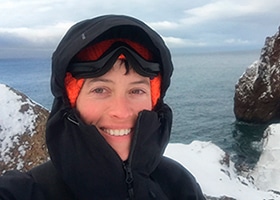
Words by Nina Gallo, Aurora Expeditions' historian and certified PTGA polar guide.
Nina has been drawn to the polar regions since her first otherworldly experience of the midnight sun in 2002. Since then she has spent time in far northern Canada, the Himalayas, the Alps and deserts in America and Australia, ever seeking out quiet, wild corners to explore. She feels immensely privileged to travel to these places and shares her passions for the natural globe, human stories and take chances with all the wonderful people she meets. Nina is the author of Antarctica, published by Australian Geographic in September 2020.
Source: https://www.auroraexpeditions.com.au/blog/antarctica-animals/
Posted by: andersonperiond.blogspot.com

0 Response to "Which Animal Has The Highest Population In Antartica"
Post a Comment